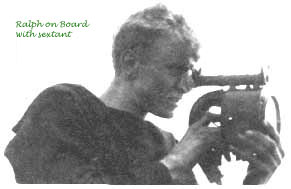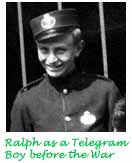

|
|||||
| Ralph Stobart Robson, signalman, life in the British Royal Navy World War Two, sinking of Prince of Wales and the Repulse, Singapore | |||||
|
|||||
|
|||||
|
The mess stools and tables were rapidly filled up with men who couldn't be accommodated with hammocks, and when I unfolded the bed it was greeted with words of consternation. The leading hand told me that I couldn't sleep on that contraption on the deck. I stood up and said to the leading hand, "Get somebody to stop me." So I lay on the bed and nothing further was said. We steamed on our way until we were about ten miles from Mombassa and then half a dozen blokes at different times asked me if I would sell them my bed. When I found that the bed was in demand, I said I would auction it. They stood around and bid for it and I received a considerable amount of money, the most I had seen since my pay out in Colombo. The sailor who bought the bed paid me in Australian money. I said it would be difficult for me to exchange this currency and asked him for another ten shillings which he gave me. It took me a long time to get rid of this money. Crossing the Indian Ocean from Colombo to Mombassa the Destroyer steamed through fine weather. The sun shone every day and one day I noticed that the ship was steaming through a collection of tropical islands clad with coco palms. Eventually the ship anchored in a bay fronting what turned out to be the Capital. We had arrived at the Seychelles and were moored in the beautiful bay of Mahe, a wooded and hilly island of great tropical charm. The most marvellous part of this was the water of the bay. As the ship lost speed and prepared to anchor the crew stood at the rails and watched in amazement as the anchor was slowly lowered into the sea. The anchor finally lay on the sandy bottom and lay in its rusty glory. The water was as clear and pellucid as the sky. No one had seen such a sight before. It seemed as if the Destroyer was suspended in mid air. The ship lay in the bay for 3 days during which time the Captain and his First Lieut. went ashore to see the Governor. For most of this time I, together with most of the crew sun bathed on the deck. I also slept on the deck on my folding bed. The crew never got ashore. The ship swung to the demands of the sea and the crew lay with their heads at the railings and watched the endless panorama passing beneath. There were fish of all sorts, octopi and other unknown creatures. 0n the sandy bottom were crabs lobsters and other crustaceans. 0n the third day the anchor was hauled aboard and we set sail for Mombassa. Mombassa was built on an island. To the south was Kilindini harbour. This was Mombassa's commercial harbour and could contain many huge ships within its buoyed anchorage. To the north was the ancient town and harbour of Mombassa with its Jesus Fort and Dhow anchorage. At the western end was a bridge, which also carried a railway line onto the mainland and on to Nairobi. The eastern, or seaward side of the port was entered by a quarter mile wide channel which was protected by two eight-ton can buoys and a boom. From Kilindini harbour we went to the naval headquarters in Mombassa. There we were sent to a white children's school which had a large house where the cooking was done, with sleeping accommodation in round rondavels. These were attractive, but open to all the local fauna, such as snakes, etc. The next morning I reported to the naval headquarters, which was a commandeered Indian girls' school two storeys high. I spent my time doing odd jobs as they had a fairly well established staff. |
|||||
|
|||||
